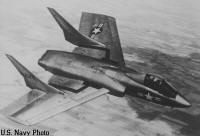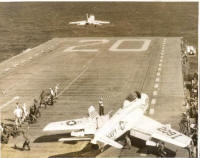|













| |
  In 1942, Schirra was appointed to the United States
Naval Academy and received a Bachelor of Science degree on June 6, 1945.
Upon graduation he was commissioned in the Navy as an ensign and
assigned to the armored battle cruiser Alaska, which was bound
for Japan, but the war had ended by the time he arrived. On February 23,
1946, he was married and later that year he was assigned to the staff of
the 7th Fleet in the Pacific in China, and in 1948, after
completing pilot's training at Pensacola Naval Air Station, Florida, he
was designated a naval aviator and assigned to Fighter Squadron 71. As
an exchange pilot with the 154th Fighter Bomber Squadron
during the Korean War, he flew 90 combat missions in F-84E jets�mainly
low-level bombing and ground-strafing operations. He was credited with
downing at least one MiG fighter and possibly a second one. In 1942, Schirra was appointed to the United States
Naval Academy and received a Bachelor of Science degree on June 6, 1945.
Upon graduation he was commissioned in the Navy as an ensign and
assigned to the armored battle cruiser Alaska, which was bound
for Japan, but the war had ended by the time he arrived. On February 23,
1946, he was married and later that year he was assigned to the staff of
the 7th Fleet in the Pacific in China, and in 1948, after
completing pilot's training at Pensacola Naval Air Station, Florida, he
was designated a naval aviator and assigned to Fighter Squadron 71. As
an exchange pilot with the 154th Fighter Bomber Squadron
during the Korean War, he flew 90 combat missions in F-84E jets�mainly
low-level bombing and ground-strafing operations. He was credited with
downing at least one MiG fighter and possibly a second one.
  From 1952 to 1954, Schirra served as a test pilot at the
Naval Ordnance Training Station at China Lake, California, where he took
part in the development of the Sidewinder air-to-air missile.
During one test flight, after he had launched the Sidewinder from his
jet, the missile doubled back in the direction of his plane and Schirra
had to use great skill to evade it. From 1954 to 1956, he was a project
pilot for the F7U-3 Cutlass jet fighter and instructor pilot on the
Cutlass and the FJ-3 Fury. In 1956 and 1957, he flew F3H-2N Demons as
Operations Officer of Fighter Squadron 124 onboard the aircraft carrier
Lexington in the Pacific. In 1957 he attended
the Naval Air Safety Officer School at the University of Southern
California, and in 1958 and 1959 he completed test pilot's training at
the Naval Air Test Center at Patuxent River, Maryland, and was assigned
to suitability development work on the F-4H jet fighter there. From 1952 to 1954, Schirra served as a test pilot at the
Naval Ordnance Training Station at China Lake, California, where he took
part in the development of the Sidewinder air-to-air missile.
During one test flight, after he had launched the Sidewinder from his
jet, the missile doubled back in the direction of his plane and Schirra
had to use great skill to evade it. From 1954 to 1956, he was a project
pilot for the F7U-3 Cutlass jet fighter and instructor pilot on the
Cutlass and the FJ-3 Fury. In 1956 and 1957, he flew F3H-2N Demons as
Operations Officer of Fighter Squadron 124 onboard the aircraft carrier
Lexington in the Pacific. In 1957 he attended
the Naval Air Safety Officer School at the University of Southern
California, and in 1958 and 1959 he completed test pilot's training at
the Naval Air Test Center at Patuxent River, Maryland, and was assigned
to suitability development work on the F-4H jet fighter there.
  Schirra was working at Patuxent River when he first
heard about the Mercury Project. He stated that at first he was not
keenly interested in being an astronaut, but the more he heard about the
idea, the more interested he got. As the doctors at the
Lovelace Clinic in Albuquerque, New Mexico, were testing him for a
position as an astronaut in the Mercury Project they discovered a polyp
on his larynx. The doctors at the Clinic offered to remove it for him
then, however the treatment included absolute silence for four days.
This was impossible at the time because he was due in Dayton, Ohio, to
take some psychological tests which would require Schirra to speak. He
was also still in the Navy, which meant that he had to consult with his
commanding officers before anything like that could be done. Later on
the medics put him on a week's silent treatment. He broke it only once
when a NASA official called from Langley to ask how his polyp was coming
along. At the end of the week the doctors decided to go ahead and
operate immediately. They arranged to give him what was normally a two
or three month treatment in two to three days in order to get it over
with. Schirra was working at Patuxent River when he first
heard about the Mercury Project. He stated that at first he was not
keenly interested in being an astronaut, but the more he heard about the
idea, the more interested he got. As the doctors at the
Lovelace Clinic in Albuquerque, New Mexico, were testing him for a
position as an astronaut in the Mercury Project they discovered a polyp
on his larynx. The doctors at the Clinic offered to remove it for him
then, however the treatment included absolute silence for four days.
This was impossible at the time because he was due in Dayton, Ohio, to
take some psychological tests which would require Schirra to speak. He
was also still in the Navy, which meant that he had to consult with his
commanding officers before anything like that could be done. Later on
the medics put him on a week's silent treatment. He broke it only once
when a NASA official called from Langley to ask how his polyp was coming
along. At the end of the week the doctors decided to go ahead and
operate immediately. They arranged to give him what was normally a two
or three month treatment in two to three days in order to get it over
with.
This was Schirra's first clue that he was on the way to becoming
one of NASA's first seven astronauts. |
Wally's
Favorite Flight Milestones:
- My favorite test flight was in the
Skyray
(F4D) thus the handle of the mispronunciation of my last name.
- I was doing a test report one evening and
went outside to see the Sputnik booster go by at Mach # 25. I
was less excited about my first Mach One test flight.
- Lovell and Conrad were class 20 classmates.
Lovell studied while Pete and I waterskied. Lovell finished
first, Pete and I tied for second. Pete did not have a boat, but
would stand on the end of a dock with his skis and a can of gas.
|
|